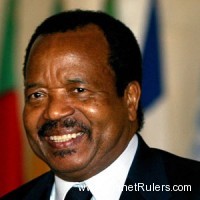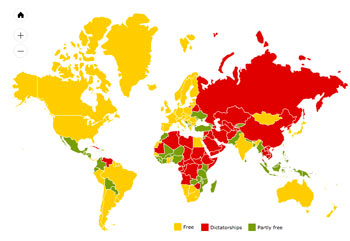Paul Biya, President of Cameroon (On Oct 7, 2018 re-elected by winning 71.3% of the vote)

Education: Licence en Droit Public, Paris, 1960; diplome, Institut d’Etudes Politiques, Paris, 1961; diplome, Institut des Hautes Etudes d’Outre-Mer, 1962; diplome, Etudes Superieures en Droit Public, 1963 .
Memberships: Mem. Union Nat. Camerouaise; Decorated chevalier Order de la Valeur Ccmerounaise; comdr. Nat. Order Fed. Republic Germany, Nat. Order Tunisia; Grand-Croix Nat. Order of Merit Senegal; grand officer Legion of Honor (France).
Career
Dept. of Foreign Development Aid, head, 1962-63; Cabinet in Ministry National. Education, director, 1964-65; Goodwill mission to Ghana and Nigeria, member, 1965; Ministry Education, Youth and Culture, secretary-general, 1965-67; Civil Cabinet of Head of State, director, 1967-68, secretary-general to president, 1968-75, minister of state, 1968-75, prime minister, 1975-82; Republic of Cameroon, president, 1982-.
Life’s Work
Considered to be a worldly and educated man, Paul Biya served Cameroon in many positions as a career bureaucrat. When he became president of his west African nation in 1982, he acted to create a more efficient government. Over time however, many critics believe Biya’s rule has become repressive and ineffective.
Paul Biya was born in 1933 in the southern Cameroonian village of Mvomeka’a. His parents were not wealthy, but his small village was a surprising springboard for his accomplishments. At seven-years-old, his parents sent him to the Catholic mission at Ndem, approximately 30 miles from his home. One of Biya’s French tutors there found his work excellent, and determined that Biya should become a priest. At age fourteen he was admitted to Edea and Akono Junior Seminaries, run by the Saint Esprit fathers. His future was brightened further when he gained admission to the Lycee General Leclerc in Yaounde, Cameroon’s capital; Lycee Leclerc is French Cameroon’s most prestigious high school. At the Lycee, Biya studied Latin, Greek, and philosophy.
Biya’s excellent work in secondary school allowed him to study at the University of Paris, where he focused on law and political science. He received his law degree in 1960. After graduation, Biya lived in France and studied public law at the Institute of Overseas Studies. In 1962, when Biya returned to Cameroon, he did so at a historic point in his nation’s history. That turning point for Cameroon would provide opportunities and difficulties for Biya in the coming years.
Division Between North and South
To understand the challenges facing Cameroon, it is important to know its history. The Republic of Cameroon was once a German protectorate. In 1916 France and the United Kingdom (U.K.) came to rule over it. The colonial rule continued even after the creation of the League of Nations, a precursor to the United Nations: In 1922 the League allowed France and the U.K. to rule the segments of Cameroon that were then under their control. The nation was divided, north from south, French from British. Although those nations no longer rule over the country, the division is still a real one in a country split by language–French and British–and by religion–Muslim and Christian.
On January 1, 1960, the French part of the country achieved independence from French rule. Named as its first president was Ahmadou Ahidjo, a Muslim from the north. The English section also gained independence on October 1, 1961; part of the British zone voted to join neighboring Nigeria, and part voted to join the former French zone. The reconfigured nation had become the Federal Republic of Cameroon.
This was the nation to which Biya returned in 1962. He was put in charge of the Department of Foreign Development Aid. That position reported directly to President Ahidjo, and also gave the young Biya experience in money matters on an international scale.
Worked Closely by President’s Side
Biya’s relationship with the president was a fascinating one, and would define much about Biya’s future. Over time, Ahidjo became Biya’s political mentor, and the men became very close. Their backgrounds, and even their personalities, were very different, however. Ahidjo had worked as a telephone operator before becoming president, and he had only an elementary school education. Although Biya came from humble beginnings, he was highly educated and enjoyed classical music and tennis. Despite these differences, Biya became a loyal follower of the president.
Under Ahidjo, Biya held a number of positions. He worked as chief of the cabinet, secretary general of the presidency, and minister of state, Cameroon’s highest-ranking minister. In 1975, Ahidjo chose him as prime minister, a position Biya held until 1982. According to the Cameroonian constitution, this made Biya Ahidjo’s legal successor.
At that time, Cameroon had a single-party government. Biya also achieved success in the party, the Cameroon National Union (CNU). His skill at party politics would prove invaluable to him later, as he jockeyed for position with Ahidjo, who served as head of the party as well as president.
Assumed Presidency
The events of November 6, 1982, are still debated by historians. On that day, President Ahidjo, citing health concerns, resigned as president. As was required by the constitution, he handed over the presidency to Biya. The action stunned the nation; Biya was largely unknown to the populace, and he was untried as a head of state.
It appears that Ahidjo expected that he would remain firmly in control of the country after his resignation. He, like many, believed the party head position to be superior to that of president. The CNU, as the only party, set policy for all government actions; the president was expected merely to carry out the directives.
Biya’s initial actions as president confirmed this view. Soon, however, the historic rivalry and tension between north and south caused him to shift gears. When he discovered that the bureaucrats from the north would not follow his lead and his orders, he began to replace some of Ahidjo’s ministers and closest aides–many of whom were northerners–with men loyal to him, often southerners.
Strengthened His Power
Two coup attempts also strengthened Biya’s control. In August of 1983 a coup attempt was seen as an effort by Ahidjo to regain power and influence. This failed coup resulted in Ahidjo’s forced resignation from the party chairmanship and his exile to France. The more deadly coup occurred in April of 1984, when members of the presidential guard loyal to Ahidjo tried to capture the palace. After three days of fighting the rebels were defeated. Ahidjo, living in France, was again officially accused of plotting the attack.
While these plots were hatched and coming undone, Biya’s star was rising. In September of 1983, he was elected president of the CNU; he abolished that party and established the Cameroon People’s Democratic Movement, or CPDM. And on January 14, 1984, he was reelected to be Cameroon’s president. Flush with success, he made the puzzling promise that there would from then on be more democracy within the party, but that no opposition could be admitted. However, repression, not democracy, has been the hallmark of his administration.
Despite the contradiction, hopes were high after Biya’s election. The economy was booming, and his focus on appointments based on merit rather than on cronyism suggested a turning point for the country. As Howard French wrote in the New York Times, “Western investors briefly considered Cameroon, rich in natural resources, to be Central Africa’s promised land.”
Biya’s rule had some successes. Later elections showed that he allowed more choice of candidates within the one party. In 1986 Cameroon resumed diplomatic relations with Israel, relations that had broken down after the 1973 Middle East war; Cameroon was only the fourth black African state to do so. And in 1987 a visit to Cameroon by the Nigerian president improved relations with that neighboring country, historically soured by border clashes.
Biya’s govern has been dogged by a number of problems. One was a severe economic crisis that began in 1984 and that continued for years. When the price of oil on the world market collapsed, the prices for Cameroon’s main crops–cocoa, cotton, coffee, and palm oil–also dropped. Oil is Cameroon’s main export, and accounted for about 35% of the budget. Beginning in 1987, Cameroon’s economy shrunk for nine consecutive years; some modest growth was evident in 1996.
Also problematic was a large and ineffectual government work force. Biya reduced the budget, and many employees were out of work. In 1988 Biya agreed to accept loans from the International Monetary Fund. Although the infusion of cash aided the economy, its austerity demands were severe for the poor population.
Ruled Through Repression and Human Rights Violations
Perhaps most characteristic of Biya’s presidency is its repressive nature. This was nowhere more evident than in the first multiparty elections to be held in Cameroon. In the late 1980s, a movement was sweeping Africa to allow candidates from more than just the official government parties. Biya resisted the movement, but finally allowed multiparty elections by mid-1990. The presidential election of 1992, however, was a shamble as an exercise in democracy. Most historians believe that Biya was defeated in that election by opposition leader John Fru Ndi. However, Biya had himself declared the winner.
Following the election, Biya declared a state of emergency to combat demonstrations. Large-scale arrests of opposition supporters occurred. An Amnesty International report found online recorded numerous instances of illegal arrests, torture, and death at the hands of Cameroonian police. In September of 1997, Amnesty International commented, “Fundamental human rights are persistently violated in Cameroon.”
Oddly, it appears that the multiparty elections, which Biya initially opposed, have the power to revive his sagging presidency. Writing for Africa Report, Mark Huband noted the ironic phenomenon: “Biya and other repressive African leaders are becoming rejuvenated with their claimed electoral successes. With enormous confidence, the dictators are bouncing back.”
Biya’s ability to manipulate public information continued throughout the 1997 presidential election. As the election approached, Biya’s government refused to allow the creation of an independent body to organize and monitor the elections. As a result, the three main opposition leaders, including Fru Ndi, opted to boycott the vote, “rather than participate in what they and many Cameroonians considered a charade,” according to Howard French in the New York Times.
The ultimate result of Biya’s repressive regime cannot be predicted, but popular unrest is growing. A reporter for The Economist wrote “Anti-government feeling, spurred by corruption, extortion and brutality, is widespread.” By apparently manipulating the electoral process fraudulently, Biya’s administration has blocked the only avenue to peaceful political change. One Cameroonian told the New York Times that Biya has built his power base exclusively around his own ethnic group, and that he has mismanaged the economy: “All of the ingredients are now in place for a civil war,” said the citizen.
Certainly, the authoritarian political structures in Cameroon were inherited by Biya; they were not entirely created by him. Historian Mark DeLancey has noted that the authoritarianism Biya inherited was so strong that Cameroonians, while dismayed with Biya’s slow pace toward open democracy, also criticize him for his inability to take charge and face opposition. The heritage of repression has been a difficult one to overcome, both for Cameroon and for its leader.
Biya had one child with his first wife, the former Jeanne Atyam. After his wife died, he remarried. The material benefits of have been great for Biya. The New York Times in 1997 reported estimates of Biya’s private fortune as $75 million. This amount reportedly is in addition to two presidential Boeing 747s, two massive homes in Cameroon, and other homes in France and Switzerland.

